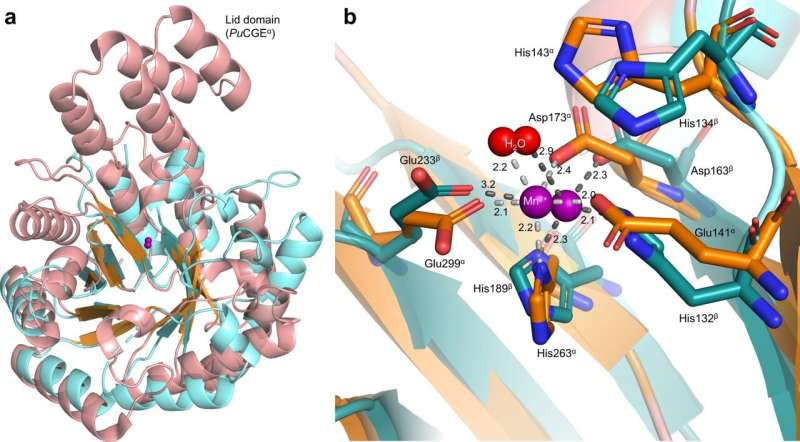This article has been reviewed according to Science X's editorial process and policies. Editors have highlighted the following attributes while ensuring the content's credibility:
fact-checked
peer-reviewed publication
trusted source
proofread
Researchers decipher enzyme scissors of intestinal microbes

A research team has found that microorganisms in the human gut utilize beta-elimination to break down plant natural products and thus make them available to humans.
Fruit and vegetables contain a variety of plant natural products such as flavonoids, which give fruits their color and are said to have health-promoting properties. Most plant natural products occur in nature as glycosides, i.e. chemical compounds with sugars.
In order for humans to absorb healthy plant natural products, the sugar must be split off in the intestine. Microorganisms in the intestinal flora help to speed up the process.
So-called C-glycosides, i.e., plant natural products with a carbon-based bond to a sugar, would even be practically indigestible without the intestinal microbes (e.g. nothofagin in rooibos tea).
A research team led by Johannes Bitter, Martin Pfeiffer and Bernd Nidetzky from the Institute of Biotechnology and Biochemical Engineering at Graz University of Technology (TU Graz) report in Nature Communications which tool the intestinal bacteria use to cleave glycosides and how it works.
Universal catalytic principle
The microbes use "enzymatic scissors" whose catalytic effect is based on so-called beta-elimination: a special type of reaction for the flexible cleavage of chemical bonds, including those of C-glycosides. The researchers succeeded in deciphering the enzyme's mode of action at an atomic level and demonstrating the highly efficient cleavage of various glycosides.
A manganese metal center in the enzyme turned out to be essential for the cleavage process and its catalysis. "These enzymatic scissors are a universal catalytic principle that allows the natural product glycosides to be broken down regardless of the type of sugar linkage," explains Nidetzky.
The investigation of the enzymatic reaction mechanisms and the catalytic steps required not only high-resolution experimental methods such as protein crystallography but also computer-aided methods by which the dynamics of the biochemical processes could be mapped.
Bacteria living on plants also use enzyme scissors
The results were obtained as part of the "doc.funds" project CATALOX in co-operation with research groups at the Medical University of Graz and the University of Graz. As part of the investigations, the researchers were able to identify the evolutionary relationship of various enzyme scissors that cleave glycosides in a large number of microorganisms.
"Bacteria in the intestinal flora have these enzyme scissors, as do a large group of plant-associated bacteria in nature," says Nidetzky.
Nidetzky doubts that in the future the enzyme scissors mechanism can be used without the involvement of microorganisms, for example, in food supplements, to improve the absorption of plant natural products. "It would be more conceivable to develop probiotics with microorganisms that have sufficient activity of these enzymes."
More information: Johannes Bitter et al, Enzymatic β-elimination in natural product O- and C-glycoside deglycosylation, Nature Communications (2023). DOI: 10.1038/s41467-023-42750-0
Journal information: Nature Communications
Provided by Graz University of Technology




















